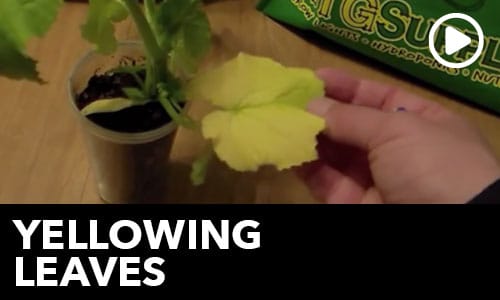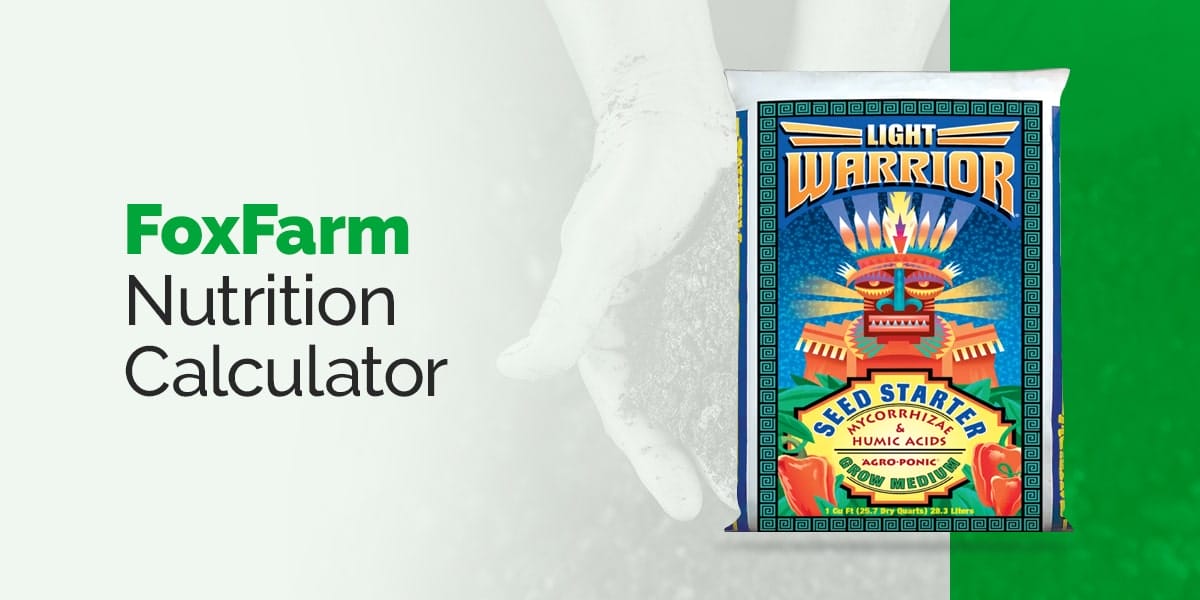Millions of years of evolution have produced incredible botanical adaptations that contribute to the amazing tenacity plants have for survival in the natural environment. The most basic requirements for plant growth can be considered common knowledge, however, plants have other lesser-known abilities that can be used to our advantage in the indoor garden. For instance, most people know plants absorb nutrients through their roots, but even long-time growers may be unaware that plants can also absorb certain nutrients through their leaves. In the gardening world this is referred to as foliar feeding, and when used as a growing practice, this technique can pay off in a number of ways. This week, we’ll cover how foliar feeding works and explain the do’s and don’t of foliar feeding. And, don’t forget the coupon code of the week for savings on foliar feeding gear!
What is Foliar Feeding?

Foliar feeding is the term used to describe applying a fertilizer or nutrient solution directly to the foliage or leaves of plants. Foliar feeding can be accomplished through the entire garden with a misting system such as is done in greenhouses or applied to individual plants by simply spraying the plants by hand. Nutrients contained within the foliar spray can then be absorbed and distributed to the rest of the plant through the vascular system, just like nutrients are carried by the arteries in humans. The idea of foliar feeding actually dates back before the turn of the 20th century, however, the concept was first proven to occur in the 1950’s. Using a foliar spray containing radioactive phosphorous and potassium, scientists at Michigan State University Department of Horticulture were able to observe the movement and usage of the irradiated nutrients through the plants using a Geiger counter. It was this research that paved the way for the development of the foliar feeding techniques we use today.
How Does Foliar Feeding Work?
Understanding some of the mechanics behind foliar feeding is important for getting the most out of your foliar regimen. Most nutrients can be absorbed through stomata, which are the small pore-like structures found on leaves. The most notable function of stomata is they can open and close to facilitate CO2, oxygen and water exchange with the atmosphere (acting similar in fashion to nostrils in humans). However, stomata can also allow the passage of nutrients, particularly when open. While stomata play an important role in foliar feeding, they are only responsible for some of the foliar nutrient absorption. An up-close examination of leaf surfaces reveals a landscape of other features that help to facilitate foliar feeding including a network of cracks in the outer waxy leaf layer called the cuticle. These cracks and other features such as specialized cell structures at the bases of trichomes called aqueous pores also contribute significantly to nutrient absorption. Once absorbed into the leaf, nutrients can be transported through the vascular system to roots, flowers, fruits, etc. for storage or use.
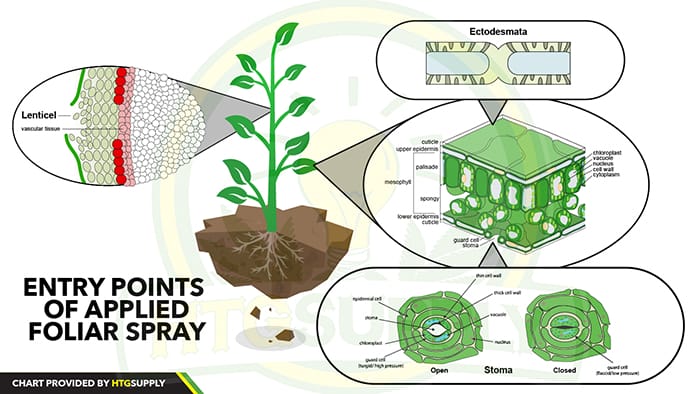
Foliar Feeding Benefits
Before we break down why it works, it’s important to note that foliar feeding should generally be used as a complementary feeding technique, meaning you should use foliar applications in addition to your soil or hydroponic fertilizer application. Plant roots are organs specifically adapted to take in nutrients, and many plants have symbiotic relationships with fungi in the root zone to help them absorb nutrients in the quantities needed. Leaves are organs that function primarily in photosynthesis. You should think of foliar feeding as a way to get a quick dose of nutrition to the foliage rather than a sustained source of nutrients for overall growth. While foliar feeding isn’t a standalone fertilizing method, it is an incredibly effective way to supercharge growth and yields. So, what makes it work so well? There are at least two benefits you gain from foliar feeding: the first is ease of absorption, and the second is speed of absorption.
Ease of Absorption – Nutrient solutions applied to soil or grow mediums are subject to a variety of factors that can prevent them from being absorbed by the roots including the pH of the grow medium as well as the presence of mineral buildup. Medium pH affects nutrient solubility which can limit nutrient uptake, while mineral buildup can cause nutrients to bind to other elements already in the soil, thereby restricting nutrient availability to the plant. Foliar application of nutrients is, for the most part, free of these obstacles. The result is that nutrients applied via foliar sprays can be absorbed easily, as much as 10 times the rate of root zone applications.
Speed of Absorption – Nutrients involved with photosynthesis will be able to get to leaves faster via foliar spraying than if applied to the soil/medium. It can take hours or days for nutrients to move from the grow medium to the roots, through the stem and into the leaves. In other words, foliar feeding is a great way to quickly get rid of any deficiencies. For example, in situations where poor soil conditions have led to nutrient deficiencies, a foliar spray will provide a much faster means of correcting the issue than a standard application. It also allows nutrient deficiencies to be addressed without the risk of overwatering in situations where soil is already wet or moist but the plant needs more nutrients. Remember – the number one problem people have growing indoors is they over water their plants.
Yet another benefit to foliar feeding is with clones. Clones do not have roots, the organs used to absorb nutrients. Foliar feeding clones has been shown to improve cloning success and cut down on clone development time because it provides the delicate clones nutrients to maximize growth. A foliar spray applied to early clones can deliver a much-needed nutrient boost before roots have even formed.
How to Foliar Feed
Foliar feeding can be incredibly beneficial to your plants when done correctly, but get it wrong and it can also be detrimental to plant health. This might sound intimidating, but it’s really not that hard once you have an understanding of the do’s and don’ts. Basically, it just comes down to mixing and applying your foliar spray properly.
How to Make Foliar Fertilizer
Almost any liquid hydroponic or soil nutrient product can be used in a foliar spray. Even soluble supplemental products that include beneficial microorganisms can be applied as part of a foliar feeding program. The first half of the foliar feeding equation involves the concentration of fertilizer used. One of the most important things to remember when mixing foliar feed is that nutrients can be absorbed efficiently through foliar applications. Therefore, nutrients should be mixed at a much lower concentration for foliar sprays than they are for general applications. Many products will provide a foliar mixing rate, but if the particular nutrient you’re using doesn’t, the general rule is to mix at no more than 50% of the recommended soil/hydroponic dose, and perhaps 25% the dose the first time you try using the nutrient in a foliar spray. For example, if the recommended usage is 20 ml per gallon, you would only use 5-10ml or less per gallon in your foliar spray. Finally, adding a surfactant or wetting agent to your mix will help to decrease the surface tension of the foliar solution which will improve the absorption rate of your spray. Most foliar specific products are formulated to include surfactants while wetting agents like Advanced Nutrients Wet Betty can be added if you’re mixing your own spray.
How to Apply Foliar Fertilizer
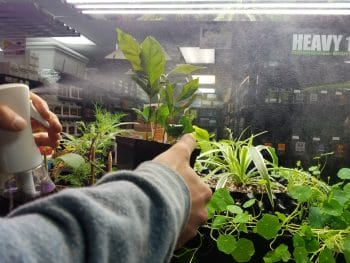
The other half of foliar feeding formula is properly applying the spray itself. First, foliar sprays should always be tested before applying to the entire crop. It can be tempting to just get the job done, but spot testing on a few leaves and giving it a day or two to see the results can prevent problems from occurring in the entire garden. Remember when using foliar fertilizer, less is also more when applying your foliar spray. In this case, we’re referring to both the amount of spray applied and the frequency of applications. Foliar spray should only be administered modestly (before it begins to run off leaves), and usually only once per week for general purpose feeding. In special cases such as the treatment of nutrient deficiencies, foliar spray could be applied more frequently, but special care should be taken to avoid overfeeding, i.e., treat calcium deficiency with a calcium-product foliar spray only. Although spraying can be done with a simple spray bottle, using a fine mist spray bottle or sprayer will apply the spray much more effectively, improving absorption and reducing the amount of spray that will need to be used.</centerBeyond delivery of the spray, timing is also an important part of applying a foliar feed. Spraying should typically be coordinated with sundown or lights-off in the indoor garden. This will prevent foliage from being burned by light magnified through solution droplets. It also reduces evaporation, which allows more of the spray to be absorbed. The growth phase of the plant when foliar feeding should also be considered. While weekly foliar feeding can continue right up until harvest for some plants, this may be undesirable for others. The general recommendation is to cease foliar fertilizer applications after the second week of the blooming phase. This will ensure the end product is not affected by any residual minerals.
Precautions
As beneficial as foliar feeding is, it can also be rendered largely ineffective or even become detrimental as a result of undesirable environmental factors, primarily high humidity. If the humidity level in the garden is already toward the high side (80% humidity or higher), foliar feeding will be less effective as plants will be less able to absorb the spray. Foliar feeding in high-humidity conditions can also promote the onset of fungal pathogens. If you have a fungal problem in your garden, you may want to avoid foliar feeding. Fungus often thrives in a moist and warm environment, and if there is already a fungus in your garden, foliar spraying could make it easier for the spores to grow and the fungus to spread. If you notice grey or white spots forming on your leaves after you start to foliar spray, you should stop foliar application of nutrients.
Quick Recap
Following these guidelines will help to ensure foliar feeding success. Here’s a quick rundown of the do’s and don’ts again:
Do’s
- If foliar mixing is not specified, mix nutrients at ¼-½ the normal rate
- Use foliar feeding as a complement to your regular feeding program
- Foliar feed to treat nutrient deficiencies and jumpstart clones
- Use a fine mist sprayer to apply spray evenly and effectively
- Use a surfactant or wetting agent to improve absorption
Don’ts
- Don’t apply foliar spray if you have any mold or fungi on the leaves.
- Don’t apply foliar spray when the lights are on
- Don’t drench your plants, a light and even mist is sufficient
- Don’t apply spray without spot testing and observing for at least a full day
- Don’t use foliar sprays where high humidity levels are a concern
- Don’t apply foliar spray after 2 weeks into the blooming phase if there is risk of the final product being affected
To sum up, the ability of plants to absorb nutrients through their foliage provides us with a reliable mechanism to be used in our quest for bigger and better yields. There’s no question as to whether or not foliar feeding works, but there are many factors that can impact the effectiveness of the technique. While it’s not completely free of risk, the sweet rewards of foliar feeding can easily be obtained without issue by following a few simple rules. Above all else, mix and apply in moderation, and always be sure to test!
____________________
Questions, tips, or tricks to share? Join the conversation, and share your foliar feeding experiences! Throw a picture on Instagram and tag us in it (@HTGSupply) – we’d love to see your results! And don’t forget to check out this week’s coupon code and sale information below! From all of us here, good luck, stay safe, and Happy Growing!
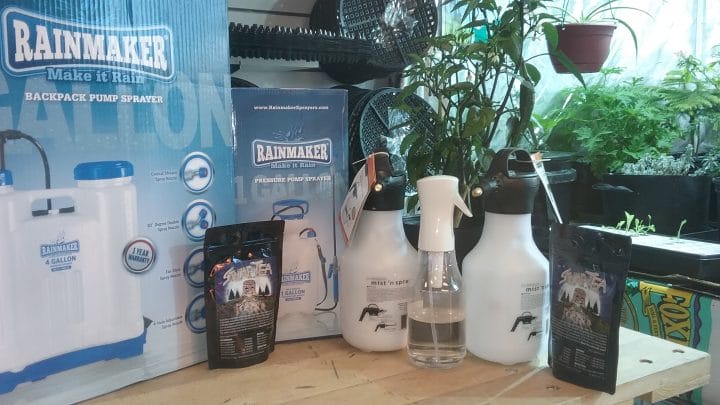
THIS WEEK’S COUPON CODE: FOLIAR
Enter this week’s promo code at checkout for a 10% discount on sprayers and spray bottles, as well as the popular foliar nutrients featured below. Visit your local HTG Supply and simply mention this article to get the deal in-store as well! Thanks again for tuning into Talking Shop with HTG Supply! Offer valid through HTGSupply.com and in-store 01/12/18-01/18/18. Cannot be combined with other offers. Follow us on social media for all the Sales, Events and Customer Appreciation Days. In addition, learn more about indoor growing and get all kinds of tips, tricks and techniques!
